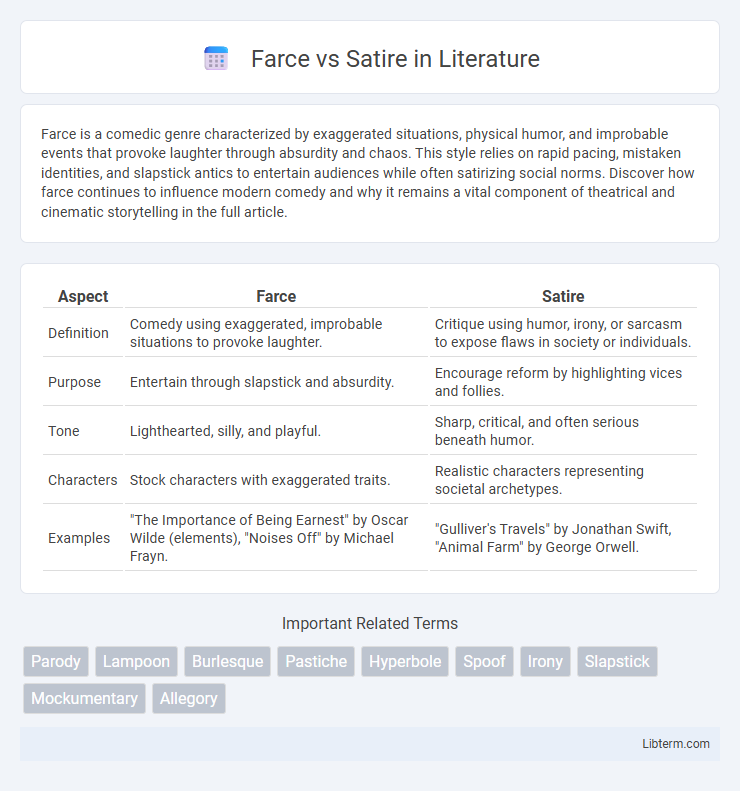Farce is a comedic genre characterized by exaggerated situations, physical humor, and improbable events that provoke laughter through absurdity and chaos. This style relies on rapid pacing, mistaken identities, and slapstick antics to entertain audiences while often satirizing social norms. Discover how farce continues to influence modern comedy and why it remains a vital component of theatrical and cinematic storytelling in the full article.
Table of Comparison
| Aspect | Farce | Satire |
|---|---|---|
| Definition | Comedy using exaggerated, improbable situations to provoke laughter. | Critique using humor, irony, or sarcasm to expose flaws in society or individuals. |
| Purpose | Entertain through slapstick and absurdity. | Encourage reform by highlighting vices and follies. |
| Tone | Lighthearted, silly, and playful. | Sharp, critical, and often serious beneath humor. |
| Characters | Stock characters with exaggerated traits. | Realistic characters representing societal archetypes. |
| Examples | "The Importance of Being Earnest" by Oscar Wilde (elements), "Noises Off" by Michael Frayn. | "Gulliver's Travels" by Jonathan Swift, "Animal Farm" by George Orwell. |
Introduction to Farce and Satire
Farce is a comedic genre characterized by exaggerated physical humor, absurd situations, and rapid-paced action designed to provoke laughter through ridiculousness. Satire uses humor, irony, and exaggeration to criticize or expose societal vices and human folly, often encouraging reflection and reform. Both forms rely on humor but differ in intent, with farce emphasizing entertainment and satire focusing on social commentary.
Defining Farce: Key Characteristics
Farce is a comedic genre characterized by exaggerated physical humor, improbable situations, and rapid pace, often relying on slapstick and absurdity to provoke laughter. Its key features include broad, stereotypical characters, misunderstandings, and improbable coincidences that escalate chaos within the narrative. Unlike satire, which aims to critique societal issues through wit and irony, farce prioritizes entertainment through outrageous scenarios and exaggerated actions without necessarily delivering a moral or political message.
Defining Satire: Essential Elements
Satire employs humor, irony, and exaggeration to critique and expose human vices or societal flaws, aiming to provoke thought and promote change. Its essential elements include wit, sarcasm, and the presence of a clear target--often political, social, or cultural institutions. Unlike farce, satire relies on subtlety and nuanced commentary rather than broad, absurd humor.
Historical Origins of Farce and Satire
Farce originated in medieval European theatre as a form of low comedy characterized by exaggerated characters and improbable situations, often performed in vernacular languages to entertain common audiences. Satire has roots in ancient Roman literature, with playwrights like Juvenal and Horace using humor, irony, and ridicule to criticize social corruption and human vices, aiming to provoke reform. Both genres evolved to reflect societal values, but farce emphasizes physical humor and absurdity, while satire relies on wit and social commentary.
Techniques Used in Farce vs Satire
Farce employs exaggerated physical comedy, slapstick, improbable situations, and rapid pacing to provoke laughter through absurdity and chaos. Satire utilizes irony, sarcasm, parody, and allegory to criticize social, political, or moral issues by exposing hypocrisy and prompting reflection. Both techniques use humor but differ in intent: farce aims primarily for entertainment, while satire seeks to inspire change or awareness.
Purposes and Goals: Farce Compared to Satire
Farce aims to entertain through exaggerated, improbable situations and physical humor, focusing on eliciting immediate laughter without deep social critique. In contrast, satire seeks to expose and criticize societal flaws, vices, or follies by using irony, wit, and sarcasm to provoke thought and encourage reform. While farce prioritizes pure amusement and absurdity, satire targets intellectual engagement and the promotion of moral or political change.
Notable Examples of Farce in Literature and Media
Notable examples of farce in literature and media include Moliere's play "The Misanthrope," which employs exaggerated characters and absurd situations to provoke laughter through social ridicule. In television, the British series "Fawlty Towers" exemplifies farce with its rapid-paced dialogue, physical comedy, and chaotic misunderstandings. These works utilize high-energy antics and improbable events to emphasize humor rooted in human folly and irrational behavior.
Prominent Instances of Satire in Culture
Satire employs humor, irony, and exaggeration to critique societal and political issues, unlike farce which relies on absurd situations and slapstick comedy for entertainment. Prominent instances of satire in culture include Jonathan Swift's "Gulliver's Travels," George Orwell's "Animal Farm," and the TV show "The Daily Show," all sharply exposing human follies and institutional corruption. These works use satire to provoke thought and inspire change by highlighting underlying truths in a humorous yet impactful manner.
Audience Reactions: Laughing at vs Laughing with
Farce evokes audience reactions through exaggerated, improbable situations that provoke laughter at the characters' absurdity and mishaps, often highlighting human folly in a superficial manner. Satire engages viewers by encouraging them to laugh with the subject, using wit and irony to expose and critique social, political, or moral issues, prompting reflection alongside amusement. The key distinction lies in farce aiming for immediate comedic relief through slapstick humor, whereas satire fosters a deeper connection by blending humor with insightful commentary.
Choosing Between Farce and Satire in Creative Writing
Choosing between farce and satire in creative writing depends on the desired impact and tone; farce employs exaggerated, absurd situations to provoke laughter through physical humor and ridiculous scenarios, while satire uses wit and irony to critique social, political, or cultural issues. Writers seeking to entertain with slapstick humor and ludicrous plots often favor farce, whereas those aiming to stimulate thought and expose hypocrisy through clever commentary lean toward satire. Understanding the audience's expectations and the message's seriousness guides the effective selection between these two distinct comedic approaches.
Farce Infographic

 libterm.com
libterm.com